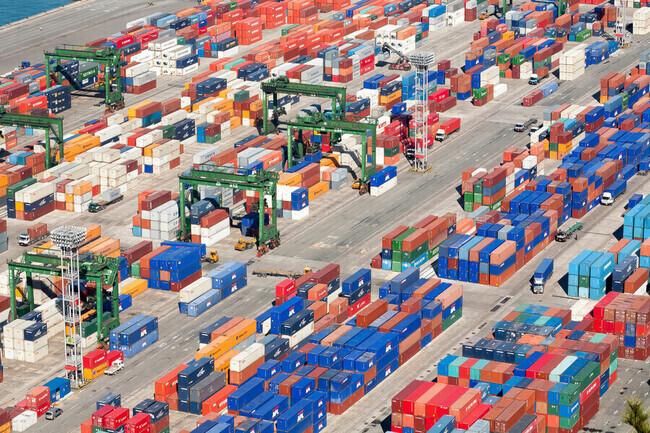hankyoreh
Links to other country sites 다른 나라 사이트 링크
US overtakes China as Korea’s top export market, prompting trade sanction jitters

The US has surpassed China as South Korea’s largest export market. Amid this shift, some have speculated that South Korea will someday become a target of US sanctions.
According to a report on changes in South Korea’s exports to the US published by the Bank of Korea on Thursday, South Korean exports in the first quarter of this year totaled US$31 billion, surpassing the US$30.9 billion recorded for the second quarter of 2003 for the first time. The US comprised 18% of all Korean exports.
The report credited consistent consumption and demand among US consumers, as well as industrial policies such as the Inflation Reduction Act, leading to an overall increase in direct investment in the US from Korean firms that manufacture semiconductors and rechargeable batteries. Korea’s central bank forecasted a continued increase in Korean exports to the US in the short term.
Revitalized US consumption and investment have positively affected direct exports as well as indirect exports, which are Korean goods that go through China and Southeast Asian countries. Also, as Korean firms invest more in the US, the tendency is for more Korean exports to flow toward the US. Since 2020, American manufacturing has also been increasingly relying on Korean products.
However, exports resulting from direct Korean investment in the US are expected to decline in the mid- to long term. The US industrial sector relies more on domestically produced goods than intermediate goods, or semi-finished products. Additionally, the high cost of producing goods within the US makes it difficult for Korean SMEs to enter the market, even as large Korean firms increase their direct investment in the US. When Korean capital enters markets in countries like China and Vietnam, SMEs comprise around 40% of that investment, while in the US it’s around 20% or less.
The report also took note of the risks arising from Korean firms reducing their investments in cutting-edge industries and Korea’s increasing exposure to the danger of brain drain.
Furthermore, as South Korea’s trade surplus with the US grows bigger, so does the risk of trade sanctions.
“In the past, when the US’ trade deficit with South Korea grew too large or when the public was concerned with protecting domestic industry, Washington chose to ramp up sanctions,” the report stated, alluding to the Trump administration’s calls for renegotiating the US’ free trade agreement with South Korea from 2017 to 2018. The Trump administration also pursued safeguard measures (the ability to temporarily restrict imports of specific products).
“If we increase our exports of energy and agricultural products to the US, we can preemptively alleviate trade risks while decreasing the domestic inflation risk,” said Nam Seok-mo, the head of international trade research at the Bank of Korea.
By Kim Hoe-seung, senior staff writer
Please direct questions or comments to [english@hani.co.kr]

Editorial・opinion
![[Editorial] Yoon must halt procurement of SM-3 interceptor missiles [Editorial] Yoon must halt procurement of SM-3 interceptor missiles](https://flexible.img.hani.co.kr/flexible/normal/500/300/imgdb/child/2024/0501/17145495551605_1717145495195344.jpg) [Editorial] Yoon must halt procurement of SM-3 interceptor missiles
[Editorial] Yoon must halt procurement of SM-3 interceptor missiles![[Guest essay] Maybe Korea’s rapid population decline is an opportunity, not a crisis [Guest essay] Maybe Korea’s rapid population decline is an opportunity, not a crisis](https://flexible.img.hani.co.kr/flexible/normal/500/300/imgdb/original/2024/0430/9417144634983596.jpg) [Guest essay] Maybe Korea’s rapid population decline is an opportunity, not a crisis
[Guest essay] Maybe Korea’s rapid population decline is an opportunity, not a crisis- [Column] Can Yoon steer diplomacy with Russia, China back on track?
- [Column] Season 2 of special prosecutor probe may be coming to Korea soon
- [Column] Park Geun-hye déjà vu in Yoon Suk-yeol
- [Editorial] New weight of N. Korea’s nuclear threats makes dialogue all the more urgent
- [Guest essay] The real reason Korea’s new right wants to dub Rhee a founding father
- [Column] ‘Choson’: Is it time we start referring to N. Korea in its own terms?
- [Editorial] Japan’s rewriting of history with Korea has gone too far
- [Column] The president’s questionable capacity for dialogue
Most viewed articles
- 1Months and months of overdue wages are pushing migrant workers in Korea into debt
- 2Trump asks why US would defend Korea, hints at hiking Seoul’s defense cost burden
- 3[Editorial] Yoon must halt procurement of SM-3 interceptor missiles
- 4At heart of West’s handwringing over Chinese ‘overcapacity,’ a battle to lead key future industries
- 5[Guest essay] Maybe Korea’s rapid population decline is an opportunity, not a crisis
- 61 in 3 S. Korean security experts support nuclear armament, CSIS finds
- 7Fruitless Yoon-Lee summit inflames partisan tensions in Korea
- 8First meeting between Yoon, Lee in 2 years ends without compromise or agreement
- 9Under conservative chief, Korea’s TRC brands teenage wartime massacre victims as traitors
- 10[Column] Park Geun-hye déjà vu in Yoon Suk-yeol